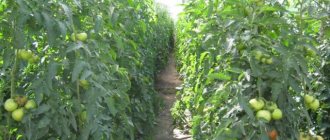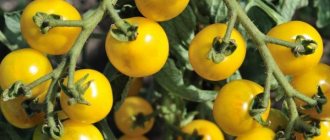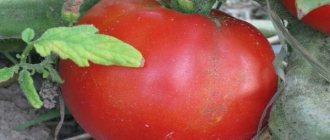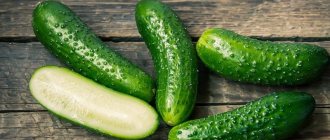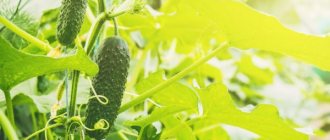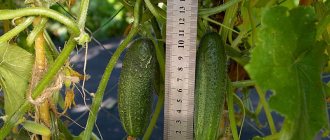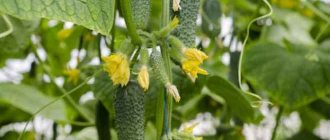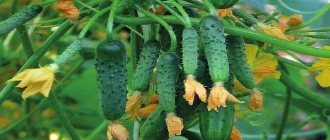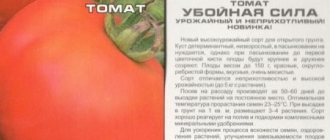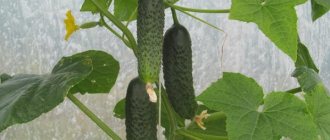Vegetable growing » Cucumbers
0
1515
Article rating
Kira Stoletova
The choice of cucumber varieties for planting depends on the needs of the gardener. The cucumber variety Bogatyrskaya sila takes root well, is easy to care for and does not require frequent watering, and therefore will be an excellent choice for planting on the site.
Characteristics of the cucumber variety Bogatyrskaya sila
Characteristics of cucumbers Bogatyr power
Cucumber Bogatyrskaya sila f1 is a hybrid that Russian agro breeders worked on to create. A relatively new hybrid ultra-early variety, the fruits of which ripen 35-40 after germination of seedlings.
Bogatyrskaya sila gherkins are used for fresh consumption and for preparing salads. In addition, cucumbers are suitable for various types of processing (for pickling, preservation or pickling), as a result of which the fruits of the variety do not lose their taste.
Characteristics of the variety:
- Bushes of the parthenocarpic type grow up to 2 meters and have moderate branching with a small number of lateral shoots capable of bearing fruit;
- Description of flowering: cucumbers are characterized by female-type flowering with self-pollinating flowers of a rich yellow color;
- The tops of the bushes are medium in size with wavy edges and are painted in a rich green color;
- Description of cucumbers: fruits Bogatyrskaya sila f1 reach a length of 9-13 cm and grow in a cylindrical shape;
- Cucumbers are characterized by a dense peel with frequently spaced bumps and slight pubescence of a whitish color;
- The gherkin pulp is elastic, crispy, juicy with a small seed sac;
- Taste characteristics: the variety is famous for its sweet, aromatic fruits.
Fetal characteristics
The greens of this variety are small in size and rarely grow to 13 cm. The genetic ability of the hybrid to stop the growth of fruits ensures good taste for the entire crop. Firstly, cucumbers do not outgrow, and secondly, nutrients are transferred to the newly formed ovaries. The fruits are oval in shape, thickened at the base (diameter 3-4 cm). Peel:
- dense;
- elastic;
- very lumpy.
The pubescence is medium white. The pulp is devoid of bitterness, has a slightly sweetish taste, and there is enough juice. The aroma is classic, cucumber. The fruit has few seeds and they are small.
In terms of culinary use, the variety can be called universal. They are great for fresh consumption and for canning. Cucumbers fully retain their physical qualities after heat treatment. This allows them to be preserved on an industrial scale. This is one of the few varieties that are suitable for storing fresh or frozen for the winter.
Pros and cons of the variety
The growing period of the hybrid Bogatyrskaya sila f1 allows us to highlight the advantages and disadvantages of the variety. Thus, vegetable growers suggest familiarizing yourself with the list of positive characteristics of cultivating the variety.
pros
- Bogatyrskaya sila cucumbers, like Grandma’s secret f1, are record holders, since over the entire season 1 bush produces more than 20 kg of cucumbers;
- Excellent taste of cucumbers;
- The plant does not require pollination by insects;
- The variety is famous for its rapid fruit ripening;
- Resistance to transportability and long-term storage of fruits Bogatyr power;
- Cucumbers are famous for their resistance to major crop diseases;
- Excellent external characteristics of the variety’s fruits;
- The versatility of using gherkins Bogatyr strength f1.
Minuses
Breeders note that cucumbers were developed taking into account all the disadvantages that other varieties have. However, vegetable growers who cultivate Bogatyrskaya sila cucumbers note that the variety still has a drawback - the variety requires regular watering.
Cucumber
Cucumber “Bogatyrskaya sila” is a self-pollinating, early-ripening variety developed by domestic breeders of the Russian State Agrarian University-Moscow Agricultural Academy. The variety is produced under the sign and is one of the most popular among summer residents. If you believe the reviews, with proper care and good agricultural technology, you can harvest over 20 kilograms of crispy, tasty greens from one bush.
Description of the hybrid
The “heroic strength” cucumber appeared on the market a long time ago, but in the short period of its existence it managed to become popular among summer residents. The variety has a bunch type of fruiting.
The plant is characterized by abundant bunched ovaries, each of which has six to ten fruits.
The duration of the growing season is until the onset of cold weather, and in regions where the climate is already cool, fruiting ends at the end of August. In the southern regions, the variety bears fruit until September.
The unique ability of the plant to produce fruit using the bunch method allows you to increase productivity and makes the “heroic strength” cucumber very popular not only among gardeners, but also among farmers.
Characteristic
The variety is suitable for growing in open ground, greenhouses, and tunnels. As follows from the description, “heroic strength” cucumbers can be grown in any region. The variety is productive. The length of each cucumber is 12 cm, diameter is 3-3.5 cm. The bushes are capable of self-regulating growth and produce good growth of lateral shoots. Dense lashes wrap around the main stem.
The leaves of the plant are dark green, the root system is powerful, and the trunk is strong. Because of these characteristics, the variety got its name - “heroic strength”. Cucumber has unique resistance to various diseases. It is not susceptible to powdery mildew, downy mildew, mosaic virus, or olive blight.
But pests attack it quite often. The main plant pests are mites and aphids. To prevent their appearance, plants are treated with chemicals such as Inta-Vir, Metaldehyde and others. You can use ash and slaked lime, as well as other methods of pest control.
Fruit
According to reviews, “heroic strength” cucumbers have a regular, even shape. They have limited growth. All cucumbers stop growing at about 15 cm. As a result of this self-regulation, the harvested crop has a beautiful appearance, since all cucumbers are even in length and thickness.
Judging by the description of the variety, “heroic strength” cucumbers are juicy, dense, with a pronounced cucumber taste and aroma. The skin is dark green and dense. This allows you to preserve the taste of the fruit during canning.
Features of cultivation
In order to grow “heroic strength” cucumbers (see photo in the article) beautiful and tasty, you need to plant the plants correctly and provide them with proper care. Not only the amount of harvest, but also the duration of the growing season depends on this.
The peculiarity of bunch cucumbers is that they need regular feeding. This is due to the fact that the bunch type of fruiting requires the plant to use a large amount of nutrients. They need to be replenished regularly.
Growing plants
Cucumbers can be grown in seedlings, or they can be sown directly into the ground.
To grow seedlings, it is necessary to determine the timing of planting plants in permanent places. Cucumber seedlings are planted at the age of 23-25 days. To this period add 5 days for germination. Having decided on the timing, you can start sowing.
To grow seedlings, you need containers measuring at least 8 x 8 cm. They are filled with soil for growing vegetable seedlings. A hole 1.5-2 cm deep is made in the center. A seed is placed on its bottom. The crops are watered and placed in a warm, bright place. After about 5-7 days, sprouts will appear.
As soon as the seedlings are two weeks old, they need to be hardened off. To do this, it is taken into the greenhouse for a week, leaving it there first for 30 minutes, and then the stay time is increased. By the time of planting, the plants should be hardened.
You can grow cucumbers by direct sowing in the ground. To do this, seeds are sown in pre-prepared and heated beds. To increase germination, it is recommended to cover the top of the ridge with film.
Transplanting
With the seedling method of growing, plants are planted in beds, maintaining a distance between bushes of at least 30 cm. In a greenhouse, cucumbers are grown in one row. In open ground you can grow two or more plants side by side. In this case, the row spacing is maintained at a distance of at least 40 cm. When planting seedlings, it is recommended to immediately tie them up, which will simplify further care of the bushes.
Cucumber seedlings are planted in pre-prepared beds. They must be well dug up. Humus must be added.
For each plant, a hole is made, at the bottom of which it is recommended to lay drainage and add several granules of mineral fertilizers. After planting, the seedlings are watered and immediately tied up.
Increased yield
As follows from the description of the variety, “heroic strength” cucumbers (photos are presented in the article) are not quite ordinary. This is a culture with a bunch type of ovary.
Cucumbers are moisture-loving vegetables that do not tolerate drying out of the soil. Because of this feature, the soil is kept moist.
Based on the characteristics of the crop, vegetable growers have long learned to increase productivity. To do this, they practice pinching the lashes and provide special care.
Sometimes stopping watering helps stimulate the plant to produce more. At such moments, the plant begins to “think” that it may die.
In this situation, it begins to actively bear fruit in order to preserve offspring.
There are other methods to increase yield. These include mixed plantings of different varieties and hybrids. Typically, this method is used when growing crops in open ground. Gardeners alternate hybrid bushes with bee-pollinated ones.
Timely application of fertilizers shows good results. Cucumbers are voracious plants. They need feeding, which is done once every two weeks. This method allows the bush to strengthen the root system, gain strength, and begin to actively form greenery.
When growing the “heroic strength” variety, attention should be paid to the support. In general, these cucumbers are climbing cucumbers and grow best with the vertical growing method. Because of this feature, the lashes are given the opportunity to weave along a trellis, net or other support.
This method of cultivation helps not only to increase productivity, but also to save space on the site and simplify harvesting and caring for bushes. To prevent the development of diseases, it is recommended to remove yellowed leaves from plants at each harvest and inspect healthy parts of the bush for pests.
If necessary, treat the plants.
Source: https://fb.ru/article/471406/ogurets-bogatyirskaya-sila-foto-s-opisaniem-urojaynost
The best varieties of bunched cucumbers for planting in the garden
The self-pollinating and early-ripening ones are:
- Mels F1 is an ultra-early self-pollinating cucumber hybrid, from germination to fruiting 36 days. Can be planted in open ground, greenhouses made of glass, film or polycarbonate and tunnels. This bundle hybrid of cucumbers is characterized by an abundance of greens on the vines and massive ripening. Suitable for pickling, very tasty - lumpy, white-spiked, bright green, 8-10 cm long, with frequent pubescence.
- Agro produces the following bunch-type cucumbers F1 Balcony, F1 City Cucumber, F1 Hummingbird, F1 Swallowtail, F1 Labyrinth, F1 Calendar.
- Excellent results both in open ground and in greenhouses, greenhouses of Central Russia and its southern regions are shown by F1 Little Boy, F1 Junior Lieutenant, F1 Three Tankmen, F1 Buyan, F1 Maryina Roshcha, F1 Chistye Prudy.
Bunch cucumber Mels F1, City cucumber F1
A shade-tolerant variety with increased productivity - Green Wave F1. Universal, suitable for growing in greenhouses and open ground, Bogatyrskaya sila F1. Bundle cucumbers, which were bred in Holland, are characterized by early ripening of the crop and a large number of fruits about 12 cm long - Ajax F1.
Hybrid Ajax F1, Green Wave
Varieties of bunched cucumbers for open ground:
- Baby Son is an early-ripening, medium-sized, highly branched hybrid. There are 3-4 ovaries in the leaf axil. Cucumbers 6-10 cm long.
- Zyatek F1 is a bee-pollinated variety, but is a variety that produces a high yield of cucumbers;
- Dwarf is an early ripening hybrid. The plant is vigorous, highly branched. 3-4 ovaries are formed in the leaf axil. Cucumbers grow up to 10 cm long.
The group of super-tufted cucumbers also includes bee-pollinated gherkins F1 Acorn, F1 Captain, F1 Faithful Friends.
Dwarf F1, True Friends
Features of growing bunched cucumbers
How to plant bunched cucumbers in the garden. Since there are a lot of ovaries, their ripening requires additional care so that the fruits are formed.
For this purpose, bunched cucumbers for open ground or greenhouses should not be planted very densely. In the first case, there should be a maximum of 4 of them in an area of one square meter. In a greenhouse it is worth reducing this number by one.
How to form a plant. Cucumber varieties with bunched ovaries and their hybrids must be formed strictly into one stem.
Then the leaves of the main stem will be well lit, and the ovaries will receive enough nutrients. Next, you need to “blind” 3-4 nodes of the main stem, and then remove all shoots up to the trellis.
Thus, on the main stem at each node there remains one leaf and a bunch of cucumbers.
“To blind” means that everything in the axils of these leaves is removed: the emerging side shoots and the rudiments of the ovaries.
Feeding and caring for bunched cucumbers. When the main stem produces its first harvest, the plant is fed with nitrogen fertilizer and new bunches of cucumbers will begin to develop in the axils of the leaves again. Apply a small dose of complex mineral fertilizer every week until the plants produce a harvest.
Bundle varieties of cucumbers and their hybrids need to be planted rarely, no more than two plants per square meter. For good yield of cucumbers, abundant watering and regular harvesting of ripened fruits are necessary.
Harvesting. Harvest the cucumber bush at least once every two days. This will increase the rate of ripening of new ovaries and reduce the number of overgrown fruits.
What do summer residents say?
First, you can read reviews about the cucumber Beam Splendor F1. The variety is good, but like all bunched varieties it requires careful care.
Because in order to get the harvest declared on the package, you will need to care for it, like caring for a small child. Watering is regular. Feeding weekly. Collecting grown cucumbers every day.
I missed watering for several days, and the sun was hotter than before, and the ovaries will end up on the soil.
For a summer resident who is just beginning to master the cultivation of cucumbers, it is worth paying attention to varieties that are less demanding in terms of care.
Some gardeners, based on their own experience, recommend pinching the first four, rather than three, side vines. This way it is possible to achieve a higher yield from bunched cucumbers.
Source
Varieties of cucumbers with bunched ovary.
Even in a small plot you can harvest decent yields of vegetables. An example of this is the varieties of bunched cucumbers, which allow you to get a lot of fruits from a smaller area. This is due to the fact that several ovaries are formed in each node, on average 3 - 9 pieces. That is, you can collect much more cucumbers from the same garden bed.
Cucumbers do not grow large, and each plant can produce 400 - 500 of them! Just like all the others, they are divided into self- and bee-pollinated. But here there is already one more characteristic: the degree of branching. The larger it is, the higher the yield and the longer the fruiting period.
Bunch cucumbers for open ground
There are certain varieties of bunch cucumbers for open ground that will feel great in any garden:
- Baby Son is an early-ripening, medium-sized, highly branched hybrid. There are 3-4 ovaries in the leaf axil. Cucumbers 6-10 cm long.
- Zyatek F1 is a bee-pollinated variety, but is a variety that produces a high yield of cucumbers;
- Dwarf is an early ripening hybrid. The plant is vigorous, highly branched. 3-4 ovaries are formed in the leaf axil. Cucumbers grow up to 10 cm long.
The group of super-tufted cucumbers also includes bee-pollinated gherkins F1 Acorn, F1 Captain, F1 Faithful Friends.
Dwarf F1 True Friends
Read on topic:
- When to plant seedlings in 2021.
Here in Russia it is customary to grow vegetables through seedlings, otherwise they simply will not have time to ripen during the summer season. In addition, if you plant the seedlings correctly, you can get the first harvest by July and enjoy it.
- How to choose self-pollinating cucumber seeds for a greenhouse.
Every owner of a summer house or garden can certainly recommend a favorite variety of cucumbers for the greenhouse. Moreover, one that always manages to not fail in terms of productivity. But it happens that acquaintances. - Planting days in March 2021 for tomatoes.
Tomatoes are the most favorite vegetables of all gardeners. By the way, they are on any table, and how many dishes can be prepared from them! And we all know that the unforgettable tomato smell can only be found in soil-grown ones.Attention, TODAY only!
Characteristics and description
Considering the increasing prevalence of the Artist f1 tomato: the characteristics and description of the variety will allow you to understand why it is so loved by summer residents and farmers.
Tomato Artist f1 is an early ripening hybrid that begins to bear fruit from 110 days after the appearance of the first shoots. It has dense, beautiful fruits and excellent yield. Confidently winning greenhouses and the hearts of gardeners in Russia and post-Soviet countries.
Since the Artist f1 tomato is an indeterminate type, its height reaches one and a half meters, and sometimes more (depending on the height of the greenhouses). This hybrid is ideal for growing in greenhouses. It is formed into one, sometimes two stems. The leaves are medium-sized, located at a slight angle to the main stem.
Brushes are laid after 3 sheets, the first - after 9-10 sheets. Usually the plant produces a full 8 clusters, but with good care and a long growing period, it can “feed” 10-12 clusters. If you do not plan to heat the greenhouse, then after small fruits have formed on 8 clusters, pinch the stem through two leaves.
This will allow the fruits to fully form, and the plant not to waste energy on fruits that do not have time to grow and ripen.
Artist f1 is a truss-type tomato. Its brushes are distributed evenly throughout the bush on both sides of the stem. The fruits are uniform in size and very attractive in appearance. The maturation of the brushes occurs simultaneously, which allows them to be removed and transported or stored in whole brushes.
The inflorescence contains 5-8 fruits. Usually their weight ranges from 140-150 grams; in the first brush they can sometimes be slightly larger and reach 200 grams. This fruit size is ideal for canning and processing. In addition, “medium-fruited” tomatoes are in demand on the market, and therefore are competitive in the market.
Source: https://selok.info/ovoshhevodstvo/ogurtsy/ogurtsy-bogatyrskaya-sila-opisanie-sorta-foto/
Landing Features
Cucumbers can be grown in seedlings and by direct sowing in permanent beds. The variety is planted as seedlings to obtain an early harvest, or in regions with a short summer season and prolonged spring frosts.
Landing dates
Direct sowing of Bogatyrskaya sila seeds is carried out at a soil temperature of 15 degrees. As a rule, the sowing of the seeds of the variety occurs in the second half of May.
To grow cucumbers in seedlings, their seeds are planted from April 10 to April 20.
Site preparation
The hybrid Bogatyrskaya sila f1 is grown in beds protected from strong winds and located in a sunny place. To prepare the beds, in the fall the soil is dug up, cleared of weeds and manure is applied to a depth of 40 cm. In the spring, the beds for cucumbers are loosened and fed with mineral fertilizers.
Planting seeds
Before planting Bogatyrskaya sila f1 seeds in open soil, it is recommended to germinate the seed. To do this, the seeds are wrapped in damp gauze for 2-3 days and put in a warm place. Cucumber seeds are planted to a depth of 2-3 cm, sprinkled with soil and watered with settled water. Afterwards, the beds must be wrapped with thick film to prevent the seeds from freezing.
Planting seedlings
Bogatyrskaya sila f1 seedlings are grown in nutritious soil, which includes soil from the beds, peat, humus and sawdust. For treatment, the soil is doused with boiling water.
2 seeds of Bogatyrskaya sila cucumbers are planted in each container with soil and watered with warm water. After seed germination, the seedlings are removed to a well-lit place, for example, on a windowsill. After the seedlings reach a size of 20-25 cm and 3-4 leaves are formed, the Bogatyrskaya Sila seedlings are transplanted into open beds to a depth of 5-7 cm. The bushes are sprinkled with soil, watered and covered with film.
Planting scheme
The hybrid Bogatyrskaya sila f1 is planted at a distance of 60 cm between the beds and 30 cm between the bushes. This planting scheme allows the bushes not to shade each other and not create inconvenience during harvesting.
Resistance to diseases and pests
The Bogatyrskaya sila variety is quite resistant to the main types of diseases: powdery mildew, downy mildew, brown spot, gray rot.
Attention!
Olive spot threatens the plant, but only if the plant is weakened and does not receive nutrients through fertilizing.
The disease first affects the upper part of the bush and spreads quickly. Olive spot is also dangerous for the root system. This is observed in any hybrid variety with a bunch fruiting method.
The variety is susceptible to bacteria and fungi. For prevention, you need to properly prepare the land for planting. In the fall, after harvesting, it is important to remove not only the bushes themselves, but also:
- the entire root system;
- remains of weeds.
And then dig up the soil well. It is recommended to plant the plant early (late April or May), so bacteria will develop as soil temperatures rise. Traditional root powders will help prevent their appearance and development:
- tobacco;
- ash.
A frequent pest of Bogatyrskaya sila cucumbers is the cotton (melon) aphid. It develops in conditions of high humidity, and this variety requires abundant watering. When aphids first appear, the bushes should be treated:
- soap solution;
- soda;
- slaked lime.
If the colony has managed to grow and the affected area is already large, chemical insecticides should be used to combat this pest:
- Inta-vir;
- Aktofit;
- Fuafon and the like.
If you take care in time to protect your cucumber beds from slug invasion, then the use of chemicals may not be necessary. To do this, sprinkle something hard around the beds. Suitable:
- ash;
- eggshell;
- calcined salt.
The pest's delicate skin is not adapted to overcome such obstacles.
For any variety grown in a greenhouse, whitefly is dangerous. It's easy to notice. There are always a lot of them on the back side, and when you touch the bushes, the whiteflies rise upward, forming a dense cloud. The greenhouse can be protected from its invasion by installing nets and adhesive tapes. Tobacco next to the cucumbers will also help; it will distract the whitefly.
Care
An integral part of growing crops are agrotechnical procedures, the observance of which is mandatory. Vegetable growers note that the Bogatyrskaya sila f1 variety requires regular watering, fertilizing, hilling and tying up the bushes of the variety.
Watering
Bogatyr's power cucumbers need to be watered once every 2-3 days. It is especially important to comply with watering work at the time of ripening of the gherkins. Water the cucumbers with warm, settled water. Per 1 m2, 10 liters of irrigation liquid are added before the fruits ripen and 20 liters after the gherkins begin to set.
Garter and bush formation
It is necessary to tie up the bushes of the variety as they grow. Plants are formed by Bogatyr strength to vertical supports. In addition, cucumber bushes need pinching.
Top dressing
It is recommended to feed the Bogatyrskaya sila hybrid from the moment the bushes of the variety bloom. It is necessary to fertilize the soil with complex fertilizers that contain potassium and phosphorus.
You can also feed the variety with folk solutions made from manure, droppings, or urea.
Hilling
It is recommended to hill up beds with cucumbers along with loosening. Both procedures are carried out after watering the soil. It is recommended to loosen the beds with cucumbers with a pitchfork so as not to harm the roots of the plant. Thanks to these agrotechnical procedures, the stagnant soil surface is removed and the main root of the plant is strengthened.
Growing plants
Cucumbers can be grown in seedlings, or they can be sown directly into the ground.
To grow seedlings, it is necessary to determine the timing of planting plants in permanent places. Cucumber seedlings are planted at the age of 23-25 days. To this period add 5 days for germination. Having decided on the timing, you can start sowing.
To grow seedlings, you need containers measuring at least 8 x 8 cm. They are filled with soil for growing vegetable seedlings. A hole 1.5-2 cm deep is made in the center. A seed is placed on its bottom. The crops are watered and placed in a warm, bright place. After about 5-7 days, sprouts will appear.
As soon as the seedlings are two weeks old, they need to be hardened off. To do this, it is taken into the greenhouse for a week, leaving it there first for 30 minutes, and then the stay time is increased. By the time of planting, the plants should be hardened.
You can grow cucumbers by direct sowing in the ground. To do this, seeds are sown in pre-prepared and heated beds. To increase germination, it is recommended to cover the top of the ridge with film.
Diseases and parasites
The bushes of the variety are immune to powdery mildew, cucumber mosaic and olive spot. However, improper planting and care of plants contribute to the infection of cucumber bushes with diseases, the description of which is presented below.
Ascochyta blight
Ascochyta blight, or black rot, is a disease in which the stem of the affected bush becomes covered with spots with a watery consistency, begins to dry out and dies. Affected plants must be removed and disinfected with a solution of urea and vitriol, or Bordeaux mixture.
Fusarium
Fusarium is a pathology as a result of which the plant begins to wither and its vessels become dark in color. In addition, fusarium causes yellowing and drying of the foliage, causing cucumber leaves to curl and die. To treat beds against fusarium, cucumbers are treated with Planriz, Quadris, Baktofit, Gymnast or Trichodermin.
Spider mite
Spider mites are small pests that, when infected, cause white dots to appear on the lower leaf blades. In addition, the leaves become covered with yellow spots and take on an unhealthy appearance, the plant’s development slows down, and the bushes themselves become covered with white cobwebs. To treat cucumbers against spider mites, the chemicals “Tiovit Jack”, “Actellik”, “Karbofos”, “Neoron” or “Dacofol” are used.
Transplanting
With the seedling method of growing, plants are planted in beds, maintaining a distance between bushes of at least 30 cm. In a greenhouse, cucumbers are grown in one row. In open ground you can grow two or more plants side by side. In this case, the row spacing is maintained at a distance of at least 40 cm. When planting seedlings, it is recommended to immediately tie them up, which will simplify further care of the bushes.
Cucumber seedlings are planted in pre-prepared beds. They must be well dug up. Humus must be added.
For each plant, a hole is made, at the bottom of which it is recommended to lay drainage and add several granules of mineral fertilizers. After planting, the seedlings are watered and immediately tied up.
